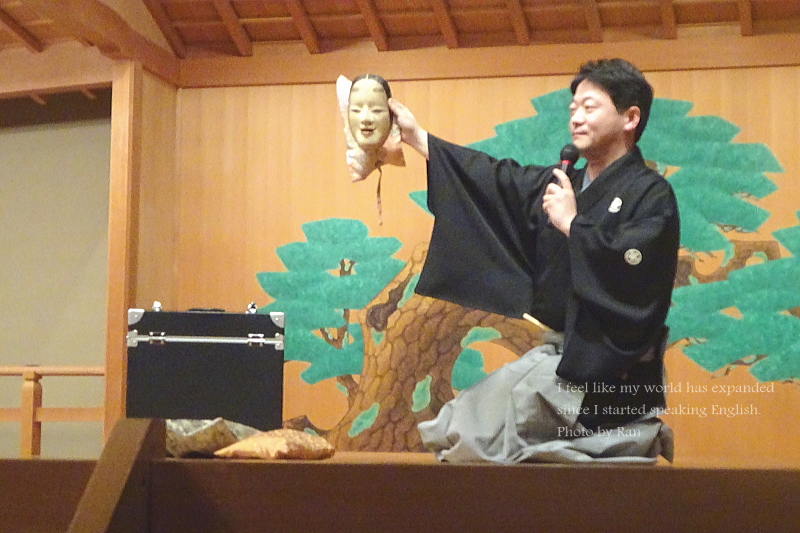日本の文化芸術の一つ、能(能楽)を英語でどう説明する?
この目で見て学びたいと、奈良にある春日野国際フォーラム甍IRAKAで行なわれた「英語で伝える日本文化~能の世界~」に参加しました。
観世流能楽師の林本大さんが日本語でわかりやすい説明をして下さり、英語通訳の方が通訳される流れでした。
まずは能面やそれぞれの担当の役割、舞台の見方、楽しみ方、能楽器などの説明。その後に、能「羽衣」の鑑賞。その後に能楽器の演奏体験をさせてもらいました。
この記事では「能を英語で説明」する場合の表現をまとめています。
※許可を得て撮影しています。
能(能楽)について
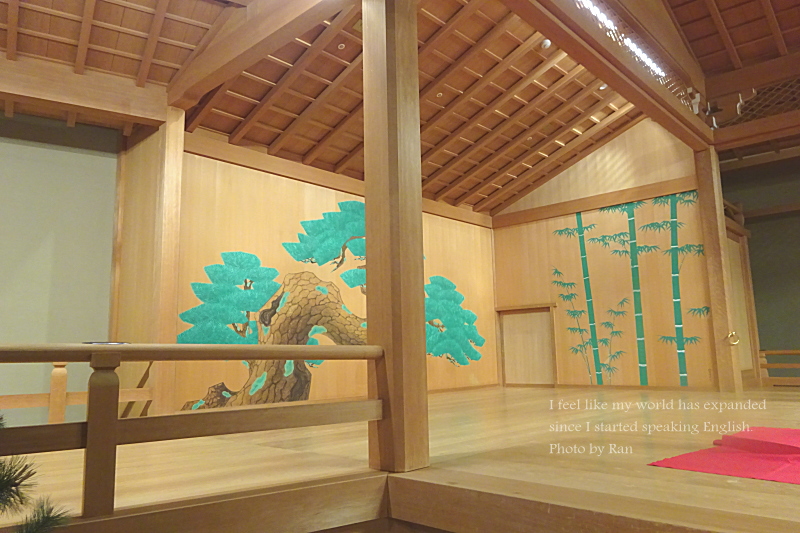
能は日本最古の演劇です。
Noh is Japan’s oldest theater.
能は劇、踊り、楽器と声楽をくみあわせたものです(ミュージカルのようなもの)。
Noh combines drama, dance, musical instrument and voice music.
能は仮面劇と呼ばれています。
Noh is called a “mask drama” or “ masked performance” .
演技者は役割に応じ、さまざまな木彫りの能面をつけます。
Depending on the actors’ roles, they wear various carved wooden Noh masks.
能の歴史について
能の歴史は奈良時代にさかのぼります。「散楽(さんがく)」&「雅楽」
「散楽」→能と狂言の要素をもつ「猿楽(さるがく)」→「能」鎌倉後期~室町前期
観阿弥(Kanami)とその子、世阿弥(Zeami)により能は大成されました。
Noh was completed by Kanami and his son, Zeami.
能の表現方法について
面自体には喜怒哀楽の表情はありません。
The mask itself does not show any emotion.
面をつけた登場人物はたくみな演技により、感情をあらわします。
The characters wearing masks express emotion with very delicate skill.
能の演目は、極力簡素化された空間で、演者たちによる余計なものをそぎ落とした動きと舞い、そして謡・囃子とで表現するものです。
The music, like the movement, is stripped down to create a sparse, concentrated atmosphere wherein the vocal and instruments can better express through nuance.
能の特徴は、シンプルさにあります。
One of Noh’s characteristics is that it is “simple.
能の動作は全て簡略化されています
All Noh movements are abbreviated.
役者は面を上下に動かし、表情をかえます。
The actors change expressions moving the masks up and down.
能舞台について
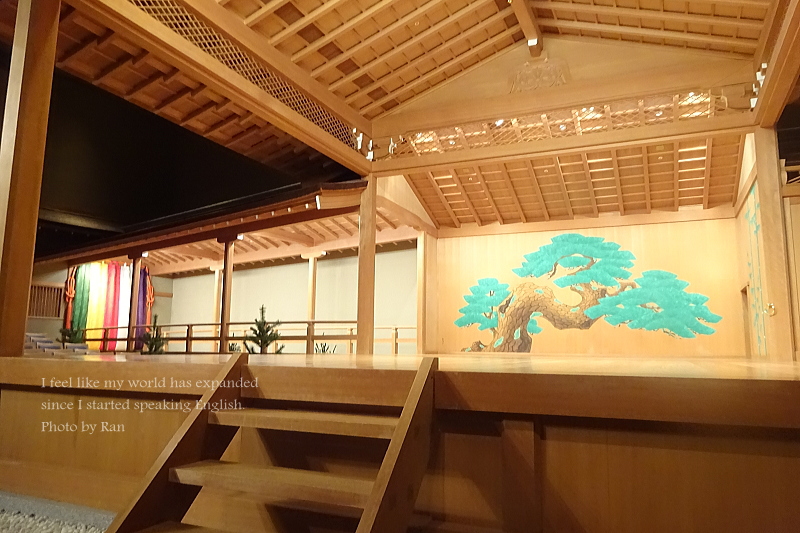
能舞台を見てみましょう。
How to look at the stage.
能舞台には屋根がああります。
Noh stage has a roof.
欄干がついた渡り廊下があります。
Noh stage has a bridge like walkway with railings.
能が演じられる能舞台は、歌舞伎や現代の演劇などとは異なり、大がかりな舞台セットや小道具などが置かれているわけではありません。
Unlike Kabuki or modern theatre, the stage for Noh does not contain large set pieces or many props.
舞台と観客を隔てる幕はなく、幕で舞台と客席とが遮断されず、開かれた空間になっています。
There aren’t any curtains between the stage and audience, The audience is not cut off from the open stage.
能の演技者について
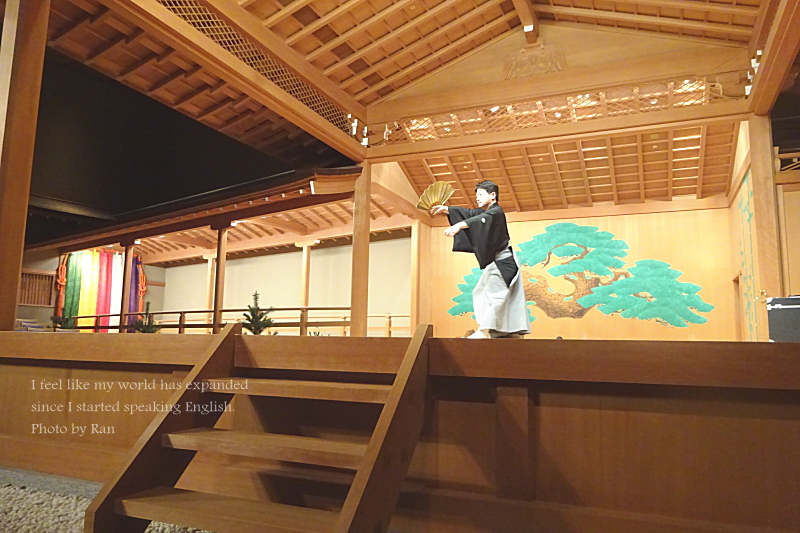
演技者 Unique roles
演技者はシテとワキに大別されます。
Roles are roughly divided into ”Shite” and ”Waki”.
シテは主役。ワキは引き立て役です。
”Shite” is the leading role and ”Waki” is a supporting role.
シテという役者が、謡い、舞います。
The ”Shite” characters song and dance.
能楽器について
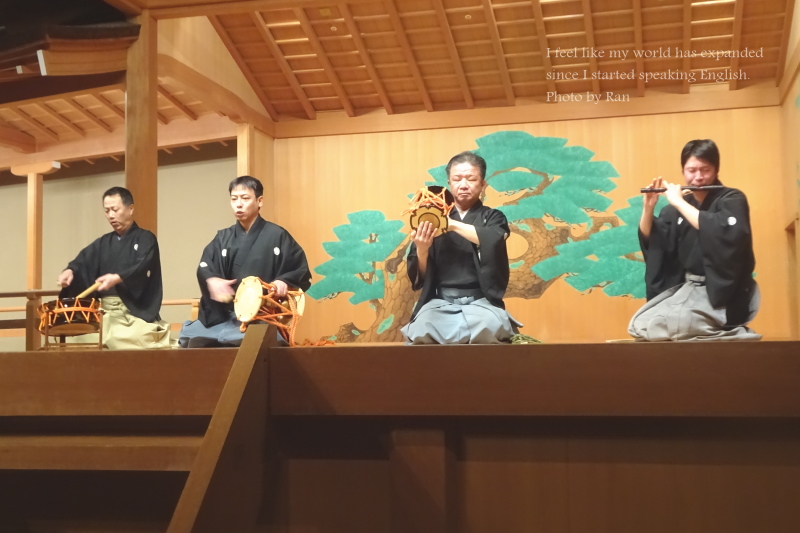
能楽器
Noh Musical instruments
楽器担当は「囃子方(はやしかた)」と呼びます。
The specialist in charge of the instrument is called the ”Hayashikata”.
笛、小鼓(こつづみ)、大鼓(おおつづみ)、太鼓(たいこ)
There are flutes, shoulder drums, and large drums.
笛:Noh flute
小鼓(こつづみ):small hand drum
大鼓(おおつづみ):large drum
太鼓(たいこ):stick drum
演奏は、ひとり一役です。自分の担当以外を演奏することはありません。
Each musician will only perform that one instrument in their career in Noh.
打楽器奏者は楽器を演奏するだけでなく、「ヤ」「ハ」「ヨーイ」「イヤー」など掛け声を掛けます。間合いをとり、演奏の位置の知らせあいをしています。
The drummers also use their voices to create ”kakegoe” or drum calls which are used before hitting the drum to help adjust the timing and drive the rhythm.
Kakegoe or drum calls
The sounds are “yo, ho, yo-ii, ii-ya”
Others can be heard from the drummers while they are playing.
笛
能管(Noh flute)
能管は調律がされていません。
Noh flute is not tuned.
笛はメロディを重視しません。そのため、能管は、一本一本で長さや穴の位置に違いがあり、調律もされていないことから、音の高さや音階が異なります。
Rhythm is in some ways more important than melody.
It is this emphasis on rhythm rather than melody that makes the fue unique.
小鼓(こつづみ)
左手で調緒(しらべお)と称する紐を握り、右肩に載せて右手で打ちます。調緒を調整することによって、4、5種類の音色を奏でることができます。
Held in the left hand at the right shoulder and struck with the right hand, the pitch of the drum can be adjusted through the squeezing and releasing of the shirabeo (chords used to hold the drum heads onto the hour glass shaped body).
Through this manipulation of the shirabeo, four distinct sounds can be made.
※日本人でありながら「能」について詳しく知りませんでした。実際の舞台を鑑賞する前に、こういった勉強会のようなイベントに参加するといいですね。日本語の説明は小学生でも理解できるよう、工夫されていました。
私は、「小鼓」を体験させてもらいました。

